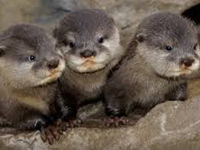

 |

|
 European Otter |
European Otter(Mammal) |
 European Otter Baby |
European Otter HabitsThe otter is a shy and solitary animal and is mostly nocturnal (active at night). It hunts in swampy areas and will often travel long distances over land, from one river system to another, in search of food.
The otter is solitary because it wanders an extremely large territory and marks it at intervals with droppings called spraint. The spraint contains a scent with acts as a signal to others otters, preventing them from wandering into its territory. Female otter with cubs will usually occupy a smaller territory within that of the male that is usually the cubs' father. The otter was once regarded as a pest and was hunted for its fur and for sport. Still, the otter population remained stable for many years. but in the 1950s it decreased as a result of pesticides which polluted the water. The poisons first affected the fish in rivers and canals, which were in turn eaten by otter. The otter population is recovering in places where hunting and pesticides have been banned. The major threat to otters today is being run over on the roads. Males patrolling their territories are particularly at risk, as they will cross newly built roads that run through their range. |
European Otter CommunicationScent is the most important sense for communication in otters. They have scent glands at the base of their tails. They deposit their musky scent, known as spraint. Each otter's characteristic scent is as unique as a fingerprint and conveys such information as identity, age, sex, and breeding condition. Scent is especially important for marking territorial boundaries.
Researchers have identified nine vocalizations for otters, including distress screams, contented coos, whines, whistles, growls, and even snarls. |
European Otter Breeding The otter breeds throughout the year. There are generally two or more female within a male's territory and the male will mate with all of them, staying with each female in her den. two to three cubs are born in an underground burrow called a holt.
The cubs are helpless for the first six weeks, during with time they survive on their mother's milk. The male plays no part in raising the cubs. After nine months, the cubs begin to spend short periods away from their mother. The cubs are independent at a year old, though they may stay in their mother's territory for a few months longer. Sadly, the European otter is now a rare signet throughout most of its range. |
European Otter Food & FeedingThe otter mainly eats fish, but it prefers eels. Still, it usually hunts for what is available and easily caught. In addition, the otter will eat crustaceans, aquatic insects, birds, frogs, and young rabbits. Otter inhabiting coastal waters prey on crabs, bogfish, and other marine fish.
Remarkably agile in the water, the otter catches fish underwater by chasing them or cornering them in clumps of weeds. After attacking a fish, the otter grips it with its sharp teeth and powerful jaws. It then carries its catch to dry land and eats it. Unlike the adults, young otter chase anything that moves, but they soon learn to because skillful underwater hunters. |
European Otter Key Facts |
| Size |
| Height: 12 inches. Length: 2-3 feet |
| Weight: 12-33 pounds, males are heavier |
| Breeding |
| Sexual maturity: Males, 18 months; females, 2 years |
| Mating: Any time; females mate 12 months after birth of previous litter |
| Gestation: 61-74 days |
| Number of young: 1-6, average 2-3 |
| Lifestyle |
| Habit: Solitary |
| Diet: Mainly fish |
| Lifespan: 9-10 years |
DID YOU KNOW?
|
CAN'T FIND WHAT YOU'RE LOOKING FOR? CLICK HERE!!!